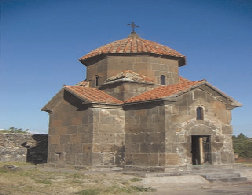Svetlana Bagdasarov
Staff Writer

Which Armenian Studies course is considered by many students to be one of the most interesting and memorable classes offered at Fresno State? If you guessed Armenian Studies 20 (Arts of Armenia), then you either know someone who has expressed enthusiasm about the course, or you have simply experienced the subject matter for yourself. In my final year as an undergraduate student, I finally had the opportunity to experience and evaluate the class for myself. With so many opinions from a wide variety of students, I was curious to find out whether or not the class would live up to all the praise.
The first day of instruction was definitely unique. Having taken numerous Armenian Studies courses at this university, I had many pre-conceived notions about the course itself, as well as the people eager to learn. As I walked inside the classroom located in the Science II building, I was surprised to say the least. Not only was the room filled to capacity, but it was full of cultural diversity as well. Many people assume that an Armenian Studies course would be taken mainly by Armenians, and might even shy away from enrolling in the course. This class proves that Armenian ancestry is not necessary if one is interested in learning more about subjects pertaining to Armenian culture.
The Arts of Armenia course, taught by Professor Barlow Der Mugrdechian, is structured clearly. The first section of the course focuses primarily on the study of Armenian architecture, such as the historic churches and notable monasteries. The next section is devoted to the study of Armenian manuscript illuminations, focusing on Christian iconography, especially the Life of Christ cycle. The final section focuses on topics such as sculpture, frescoes, mosaics, ceramics, metalwork, and textiles.

All of the material to be studied can be found on the Armenian Studies website, armenianstudies.csufresno.edu, as well as in the required textbook, The Arts of Armenia, written by Dr. Dickran Kouymjian. In addition to the written aids, Professor Der Mugrdechian elaborates on each topic with careful attention to important facts and details about the art-work. He also utilizes a video projector to incorporate images into his lectures, which is definitely an effective method for learning. With so many different ways to learn, it is truly impossible not to do well in this class.
Heidi Lea, a freshman, expressed her reasons for taking this course, “I took this class because I was interested in learning about Armenian art. I have learned so many new things about Armenian culture through this class. Studying Armenian architecture was a special treat, because I was able to gain knowledge about all of the historic churches.” Edgar Islas, also a freshman, commented, “I am so glad that I enrolled in this class, because I have learned about the many different styles of art. Although I am not Armenian, this class has helped me understand and appreciate Armenian culture.
Another first time freshman, Pang Hova Thao, proclaimed that her decision to enroll in this class was due to her curiosity about the Armenian people. “I really enjoy learning about Armenian art because it has helped me understand the country of Armenia and its distinctive culture.”
Overall, there appears to be a consensus by current and former students regarding the superior quality of the Arts of Armenia class. It is safe to say that this class will remain as a part of the Armenian Studies curriculum for many years to come.
 Hye Sharzhoom Armenian Action
Hye Sharzhoom Armenian Action